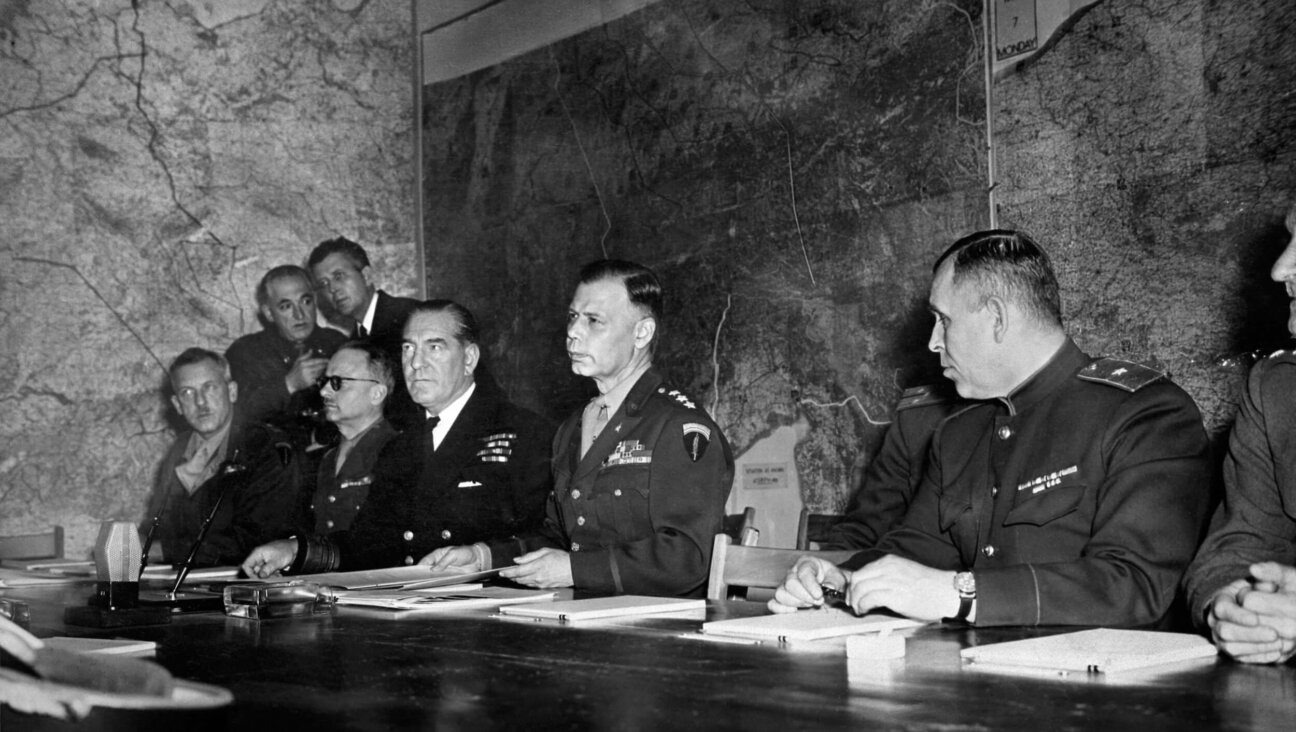This year, I learned the pain and beauty of praying outside

Image by wikimedia commons
This essay originally appeared in the New York Jewish Week.
Friday night. We are standing in a paved plaza beside Riverside Drive; the air is crisp, the fresh snow is sparkling like diamond dust in the setting sun. We are 6 feet apart and masked (I can’t wait for this combined phrase to become obsolete). We join the hazzan, chanting the Friday evening prayer, welcoming the Sabbath as the sun disappears over the Hudson River. “Come my beloved towards your bride to welcome the Sabbath.”
Suddenly I’m choked up, no longer able to sing. My eyes fill with tears and emotions. I have sung these words almost every week of my life — that’s about 2,500 times — but tonight these very familiar words feel new and deeply moving.
Perhaps it is the beauty of praying outside.
Kabbalat Shabbat, the prayer welcoming, or literally accepting, the Sabbath, is a relatively new prayer service. It was added in the 16th century by the Jewish mystical Kabbalists (note the repeating root) in the holy city of Tzfat in the Galilee. They got into the habit of leaving the city and walking out to the nearby hills and orchard. Out in nature, they sang and meditated about God’s glory as manifest in the universe and in history.
This new service was an instant hit and has become part of the prayer book canon. But for most urban dwellers, it is a rare occasion, maybe on a high school weekend trip, Shabbaton or retreat, to practice it outdoors as the Kabbalists did.
Early in the pandemic, our congregation shifted to outdoor services. We thought this would work during the summer. None of us envisioned the weekly service continuing outside through the bitter New York winter. But it did.
Perhaps it was the link to the origin of Kabbalat Shabbat, the repetition of a practice through good times and hard times, that moved me so much. We often forget to notice the magnificence of nature in the hyper-urban concrete and glass of Manhattan.
Prayer is a strange thing. We try to deeply connect with our pain and gratitude, speak to our hopes and regrets. We say these words to ourselves with a divine intention. Prayer is something that should be so personal and private, yet I find it most meaningful when done with a community.
I have come to see communal praying as a bit like therapy. In therapy we learn to hear our feelings, accept our pain and cherish our joys. But it is hard, if not impossible, to do this work alone. We need someone, the therapist, to help us see ourselves better. Someone who can give us permission to feel sadness and encourage us to celebrate success.
Community can play a similar role. It legitimizes and creates a place for deep emotions. Together, we dare to say that life is fleeting and that the universe is vast, and history has awful moments and humanity can be inspiring. We can hold these disturbing conflicting ideas because we are doing it together, and together we feel safe and accepted. This need for community is so fundamental that our numbers have grown even as the temperature dropped.
Praying on a public New York City sidewalk, I felt exposed and vulnerable at first. Some stared, others took photos on their phone or lingered, while their dog sniffed a shrub, to watch us, or even joined us. Can we do this? I’m sure those who use this spot for yoga on Sunday morning have felt this discomfort too.
The reclaiming of public space has been one of the surprising joys of the pandemic: restaurants using the parking lane for seating and closed streets becoming plazas for bikes and pedestrians. I realize how many things we could do outdoors if our city were designed to facilitate these activities. I hope we move toward making outdoor life in our city more easily accessible to all of its inhabitants.
The pandemic has stripped our service to its bare basics. We worship without a space, without chairs, with dim light and no heat. I realized that this was all we really needed. A committed group, willing to stand in the snow and sing together.
The hazzan sings, “He removes day and brings night, God is his name” in synchrony with the darkening sky. It is getting harder to read the small print in my prayer book, but I know the words by heart.
The lump in my throat loosens and I breathe in the cold air.
Marc Cousins, the architectural theorist, said in one of his lectures that, although philosophers will not tell you this, the sign of truth is that upon hearing it one breaks into tears.
That night I was touched by truth.
Was it the pain and loss of the pandemic? The fragility of life? The support of togetherness? I’m not sure, but it was real, and it was worth bundling up for and seeking out on a freezing, snowy Friday evening.
The Forward is free to read, but it isn’t free to produce

I hope you appreciated this article. Before you go, I’d like to ask you to please support the Forward.
Now more than ever, American Jews need independent news they can trust, with reporting driven by truth, not ideology. We serve you, not any ideological agenda.
At a time when other newsrooms are closing or cutting back, the Forward has removed its paywall and invested additional resources to report on the ground from Israel and around the U.S. on the impact of the war, rising antisemitism and polarized discourse.
This is a great time to support independent Jewish journalism you rely on. Make a gift today!
— Rachel Fishman Feddersen, Publisher and CEO
Support our mission to tell the Jewish story fully and fairly.
Most Popular
- 1

Culture Cardinals are Catholic, not Jewish — so why do they all wear yarmulkes?
- 2

News School Israel trip turns ‘terrifying’ for LA students attacked by Israeli teens
- 3

Fast Forward Ye debuts ‘Heil Hitler’ music video that includes a sample of a Hitler speech
- 4

Fast Forward Student suspended for ‘F— the Jews’ video defends himself on antisemitic podcast
In Case You Missed It
-

Yiddish קאָנצערט לכּבֿוד דעם ייִדישן שרײַבער און רעדאַקטאָר באָריס סאַנדלערConcert honoring Yiddish writer and editor Boris Sandler
דער בעל־שׂימחה האָט יאָרן לאַנג געדינט ווי דער רעדאַקטאָר פֿונעם ייִדישן פֿאָרווערטס.
-

Fast Forward Trump’s new pick for surgeon general blames the Nazis for pesticides on our food
-

Fast Forward Jewish feud over Trump escalates with open letter in The New York Times
-

Fast Forward First American pope, Leo XIV, studied under a leader in Jewish-Catholic relations
-
Shop the Forward Store
100% of profits support our journalism
Republish This Story
Please read before republishing
We’re happy to make this story available to republish for free, unless it originated with JTA, Haaretz or another publication (as indicated on the article) and as long as you follow our guidelines.
You must comply with the following:
- Credit the Forward
- Retain our pixel
- Preserve our canonical link in Google search
- Add a noindex tag in Google search
See our full guidelines for more information, and this guide for detail about canonical URLs.
To republish, copy the HTML by clicking on the yellow button to the right; it includes our tracking pixel, all paragraph styles and hyperlinks, the author byline and credit to the Forward. It does not include images; to avoid copyright violations, you must add them manually, following our guidelines. Please email us at [email protected], subject line “republish,” with any questions or to let us know what stories you’re picking up.















